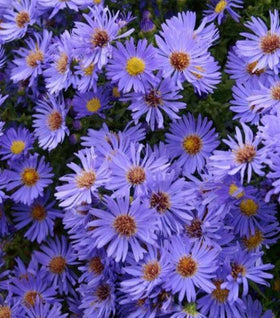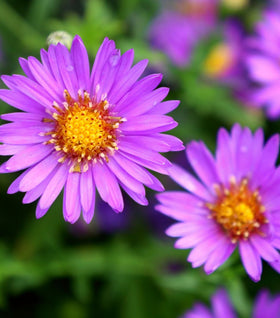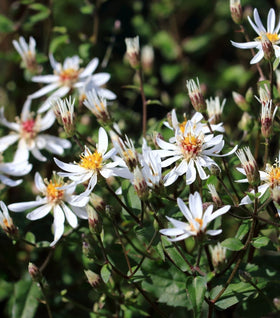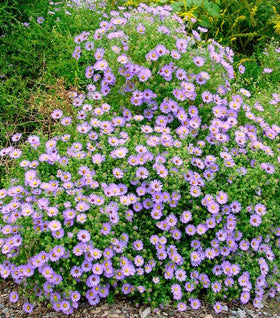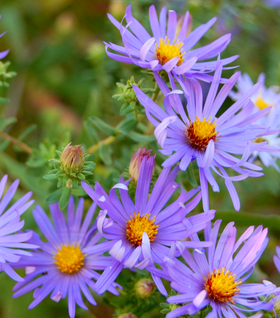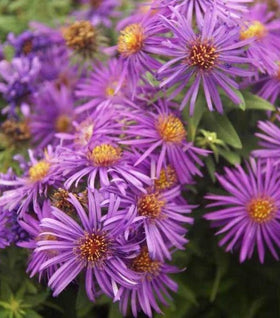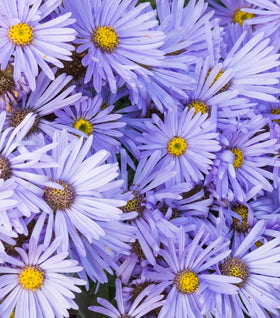Aster Plants for Sale Online
When summer begins to fade- and fall peaks its head out, most of our beautiful garden plants start to fade and slowly enter their dormancy period for the winter. However, the cooler fall days make for perfect weather to sit out and enjoy your garden! Instead of trying to enjoy a dull and faded garden in the fall, plant some Asters all around your garden and watch it stay alive throughout fall. Aster perennials bloom star-like flowers in various colors, from purple, blue, pink, white, multicolored, and more!
Their blooms blossom from August through October. Some people think their flowers look very similar to daisies. You will not be the only one or species enjoying your Aster flowers throughout their growing season. These perennials are pollinator-friendly and attract pollinators like bees, hummingbirds, butterflies, and more. Give your Asters plenty of direct sunlight throughout each day and keep their soil consistently moist, and you will enjoy their beauty from late summer through fall each year.
How to Plant Aster Plants
Before you even think about placing your Aster perennials in the ground, be sure there is no more danger of frost that year. Typically this would mean planting your perennials in mid-to-late spring. When planting, be sure to space your plants 1 to 3 feet apart. Some Asters grow bigger than others, so this is why we recommend a range of distances when planting.
The best time to water your newly planted Asters is at the time of planting. Give your plant a deep watering to ensure it begins establishing roots in its new soil conditions. One way to prevent weeds and keep the soil cool is to add a layer of mulch around your plant once it is in the soil.
How to Care for Aster Plants
Light:
If you have an area of your garden or landscape that receives full sun for the majority of the day, this is the ideal spot for your Asters to grow. If these perennials receive too much shade, it can cause them to become lanky and produce fewer flowers. We recommend 6 to 8 plus hours each day of full sunlight to ensure your Aster plants grow happy and healthy.
Soil:
The best soil conditions for Asters are well-draining, loamy soil that is slightly acidic. We recommend a pH ranging from 5.8 to 6.5. If you have alkaline soil in your garden, you can make it more acidic by adding organic matter like leaf mold, compost, or well-rotted manure. Also, it is crucial that you keep your plant's soil consistently moist but never saturated. Make sure their soil is well-draining to ensure their root system does not get root rot disease.
Water:
Keep new Aster plantings moist and on a continuous watering schedule until their flowers have finished blooming. We recommend that your plant's soil remains consistently moist but not oversaturated. Typically one inch of rain or watering once a week is the recommended amount for your Aster perennials to thrive.
One thing to note: Only water the base of your Asters and avoid getting water on their leaves and flowers. If water gets on their leaves or flowers, it could cause mildew or fungal growth.
Fertilizer:
Beginning in the spring, start to fertilize your Aster plants twice a month. We recommend that you use a balanced flower fertilizer for your moderate feeding Aster perennials. Continue to fertilize your plants until your Asters blooms begin to open. It is best to stop fertilizing your perennials in August to avoid overfertilizing them. If you do not stop fertilizing around this time, you could shorten their bloom time for that growing season.
Temperature:
Asters are frost-hardy and can withstand near-freezing temperatures for a short time. Because these plants thrive in cooler temperatures, they will last throughout winter and bloom again next year, as long as they are winterized properly.
How to Propagate Aster Plants
Asters can be propagated by rooting stem cuttings, but the easiest way to propagate them is by digging up the root clump and dividing it into pieces for replanting. There is no specific spot to cut the root clumps; they will survive no matter what. The best time to divide your Asters is in late fall or early the following spring because the plants will become established enough to blossom beautiful fall colors their first year.
How to Grow Aster Plants as Houseplants
Most people know Aster plants to be grown as perennials in gardens and landscapes; however, these flowering plants can also be excellent houseplants. When choosing their potting soil, find one that includes: quality peat moss, compost, and an all-purpose fertilizer. You can also add animal manure to help your plant's soil have as many nutrients as possible.
Place your potted Asters in front of a window that receives direct sunlight for at least 6 to 8 hours a day. Similar to watering instructions for perennial Asters, make sure their soil stays moist but never overly saturated. Asters benefit from frequent applications of a quality, all-purpose fertilizer. We recommend that you feed your plants once a month.
Aster Plant Fun Facts
- Aster plants are one of September's birth flowers
- The name "aster" comes from the Ancient Greek word for "star." As you can probably tell, this is a reference to the plant's star-shaped flowers.

